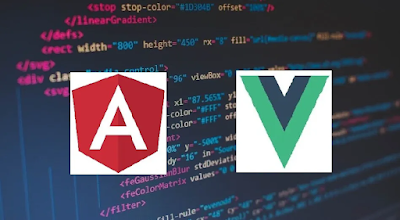This is the ultimate comparison guide for Vue.js vs. Angular.
Developers seem to be unsure which JavaScript framework to choose between Vue.js and Angular for their next project.
We’ve tried to address the confusion by offering the most comprehensive yet concise guide, helping software developers make informed decisions and build products that deliver on the anticipated goals.
Without further ado, let’s dig the gold right away!
What is Vue.js Framework?
Vue.js is a full-fledged JavaScript framework used for creating user interfaces (UIs). It’s widely used because of its simplicity and convenience. Many developers find it easy to create dynamic apps using Vue.js.
Vue.js framework employs a component-based architecture as a way to allow developers to make UI elements even more reusable with maintenance and organization benefits.
To add further, Vue.js provides data binding along with a responsive, virtual DOM, minimizing performance fall-outs by updating DOM as and when data changes. The framework has a comprehensive information base and a dedicated community, which is one of the favorites for beginners who need knowledge for little to complex tasks.
The ease of developing and a higher degree of flexibility lend credibility to Vue.js as one of the best tools for modern software development.
Pros and Cons of Vue.js
Pros
Simple and lightweight framework.
Gentle learning curve for beginners.
Versatile for both small and large projects.
Flexible component-based architecture for reusability.
Excellent documentation and vibrant community.
High performance with virtual DOM.
Cons
Smaller ecosystem compared to Angular.
Less built-in features and tooling.
Less corporate support compared to Angular.
May lack standardization in larger teams.
What is Angular Framework?
Angular framework is a JavaScript framework by Google, which helps build dynamic mobile as well as web applications. It’s widely used by developers to create single-page applications (SPAs) and considered as an ideal fit for enterprise applications.
Angular uses the MVC (Model-View-Controller) architectural design to ensure a structured, streamlined mode and pace of development. It boasts capabilities such as two-way data binding, dependency injection, and modularization, all of which contribute to the maintainability and scalability of the code.
Angular’s support for TypeScript is a praiseworthy addition. TypeScript is a superset of JavaScript used for creating robust and scalable applications. Equipped with awesome features, extensive documentation and a vibrant community, Angular is still on the list of well-known frameworks to be used by software developers for their development projects.
Pros and Cons of Angular
Pros:
Comprehensive framework for large-scale applications.
Powerful features like dependency injection.
Built-in tools for testing and debugging.
TypeScript support for robust codebase.
Strict architecture for scalability and maintainability.
Cons:
Steeper learning curve for beginners.
Complex syntax and boilerplate code.
Larger bundle size compared to Vue.js.
More opinionated structure may limit flexibility.
Regular major updates require migration efforts.
Vue.js vs. Angular: Which is better?
Refer to the table below to discover the key points of difference between Vue.js and Angular and choose what fits your requirements.
Final Word
The frontiers of the software development industry are continually shifting.
With the rise in the number of tools and frameworks available, developers find it exhausting to pick the best for their needs. We hope our comparative guide on Vue.js vs. Angular has put all your doubts to bed and geared you towards choosing the right for our business.
If you have any more questions or need further clarification, don’t hesitate to connect with us.


